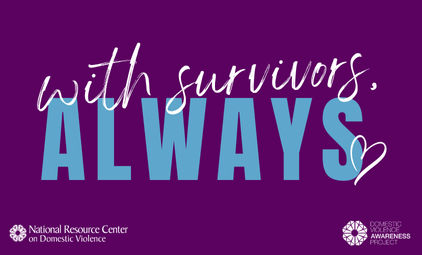By Casey Keene and Kara Cook for the National Resource Center on Domestic Violence (NRCDV)
When reflecting on the impacts of the COVID-19 pandemic on the United States and around the world, it goes without saying that the experience was traumatic. As a matter of fact, what the world experienced was collective trauma. Collective trauma is an event or series of events that affect not just one person, but a group of people. It can be rooted in oppression or discrimination, or can refer to environmental disasters and pandemics, among other crisis situations. Traumatic experiences – whether individual or collective – are inevitable, meaning that unfortunately, most of us will experience at least one during our lifetime. And even beyond our lifetimes, many of us inherit the cumulative impacts of historical trauma that reverberate across generations.
Despite the inevitability of experiencing trauma, we do not talk about it often enough. There is a certain stigma around trauma that leads us to deny or minimize our experiences with messages like “it’s not that bad” or “there are people going through worse.” In fact, mental health providers at Stella launched a campaign aimed to challenge these very messages that justify or minimize trauma through their “Your Trauma is Valid” campaign. Too often, folks’ experiences are shut down or ignored. In person and on social media, we see people making jokes about trauma and invalidating others’ experiences. By continuing to dismiss trauma and its impacts on society, mental health crises are becoming more common. It is imperative that we work to break down the stigma around trauma and begin validating individuals’ experiences. So, what can we do?
The National Center on Domestic Violence, Trauma & Mental Health (NCDVTMH) offers guidance around creating trauma-informed services and organizations that are inclusive and accessible for both advocates and the communities they serve. Their framework addresses the need for “work that is grounded in domestic and sexual violence advocacy perspectives, that incorporates an understanding of trauma and its effects, that creates accessible environments for healing, that recognizes the centrality of culture, and that is committed to social justice and human rights” (NCDVTMH, 2018).
The NCDVTMH framework is designed to counteract peoples’ experiences of trauma and dehumanization through the implementation of practices that respect and honor “each person’s experience, resilience, agency, and humanity” (NCDVTMH, 2018). This approach requires that we foster relational environments that deepen the quality of our interactions and relationships with one another. It centers dignity and humanity as the pathway to destigmatizing trauma.
There are 4 core principles underlying this framework:
1. Physical and Emotional Safety
“When we understand trauma responses as adaptations to being under siege, then part of our work is to do everything we can to reduce the likelihood that survivors will feel discounted and disempowered in our programs and systems.” - Carole Warshaw, Erin Tinnon, and Cathy Cave
Safety means different things to different people. It’s imperative that we consider safety through a racial equity lens, and engage in ongoing “self-reflection and evaluation of whether systems, policies, and procedures are facilitating feelings of safety among participants and staff” (NCDVTMH, 2018).
At the same time, trauma may be perceived differently across different cultures. The Healthcare Toolbox published by the Children’s Hospital of Philadelphia explores culturally-sensitive trauma-informed care, noting that some cultures may perceive a traumatic event as a punishment, a test/rite of passage, or a special message.
Furthermore, traumatic events and trauma responses continue to be weaponized against marginalized groups, which further perpetuates oppression and inequities these groups face on a daily basis. For example, Black girls who have mental health illnesses such as depression or anxiety are often seen as “problems” and “troublemakers,” rather than as individuals who are in need of help. Centering the voices and experiences of marginalized groups in conversations about trauma allows for increased awareness around its intersections with mental health.
That’s why being anti-racist is central to trauma-informed care. Oppression and discrimination are examples of both historical and intergenerational trauma with cumulative impacts. It is imperative that organizations work to dismantle white supremacy in order to address these traumas and facilitate healing and repair.
The Center for Health Care Strategies offers practical considerations to help health systems and provider practices incorporate a focus on racial equity in their guidance document, Incorporating Racial Equity into Trauma-Informed Care (2021).
2. Relationship and Connection
Connection and belonging are basic human needs, and valuable pathways towards healing and wellness. Fostering environments where meaningful, trusting relationships can flourish is a critical approach to creating trauma-informed, inclusive spaces.
Experiences of community trauma or mega-threats can have deep and direct impacts on our programs, especially for advocates who hold the dual identity of trauma survivors. “A mega-threat is a negative event targeting a group of people or community based on their identity followed by intensive coverage by the media or on social media” (NCDVTMH, 2023). The twin pandemics of COVID-19 and state-sanctioned racial violence revealed the need for workplace cultures and climates that center psychological safety, inclusion, and compassion from leadership.
Investing in organizational cultures that value relationships and connection can serve as an antidote to the stigma, shame, and silence around trauma that people are experiencing. Shame can create a state of being in which an individual believes they are flawed or defective as a human being. Providing open, affirming spaces for people to share their experiences without fear of judgement is crucial for avoiding re-traumatization. This depends on the development of trusting and meaningful relationships, which requires the time and investment of all parties.
More information on creating inclusive environments, services, and organizations can be found in NCDVTMH’s Core Curriculum.
3. Hope and Resilience
“Being a steady source of hope, and acknowledging, naming, and reflecting people’s profound resilience are critical parts of supporting survivors while they heal from trauma.” - Carole Warshaw, Erin Tinnon, and Cathy Cave
We know that going through a traumatic event can impact an individual for the rest of their life. Often, we see these traumatic events showing up negatively in peoples’ lives. But what if we also considered what we gain from our experiences of survival? Simply considering this question can have transformative impacts on the way we see ourselves and the possibilities for our future.
While trauma is a common human experience, so is resilience. The TAQ, How can I support survivors in building resilience?, draws attention to the fact that resilience is an innate human capacity that can be learned and developed in anyone. Additionally, it touches upon the concept of post traumatic growth, which refers to positive psychological changes one experiences as a result of enduring traumatic and challenging situations. Included in this TAQ are helpful resources and strategies for building advocates’ and survivors’ capacity for resilience.
Modeling the process of building resilience can be an exceptionally powerful strategy for advocates who are supporting survivors on their own journeys to healing. We must strive to build resilience in ourselves and our organizations in order to combat the stigma and shame associated with trauma.
Trauma is everywhere, but so is resilience - Sherry Hamby for TEDx University of the South (March 2021)
4. A Survivor-Defined Approach
“An organization with an aligned survivor-defined mission, vision and set of values is positioned to grow and change in ways that make survivors of violence safer… This work is difficult. The pull on our time, attention and resources is fierce. Interests and priorities may conflict. Alignment of mission, vision, and values is how we keep our focus and stay true advocates for survivors.” - Deborah Linnell with Jill Davies
In survivor-defined organizations, survivors are heard and respected. Partnerships with survivors are fostered and cherished. Their perspectives hold power, and guide the direction of our work. These elements are essential to honoring and destigmatizing experiences of trauma in our organizations. It means that we must ensure the meaningful involvement of survivors in our planning, evaluation, and oversight of programs. It also means we engage survivors as volunteers, staff, and in leadership roles within our organizations. It means acknowledging and embracing the survivorship of advocates.
“Engaging in survivor defined work also means that we are working to acknowledge and jointly confront the power imbalances in our interactions, while working to change the conditions that facilitate violence in our relationships and communities” (NCDVTMH, 2018). The broader work of preventing and addressing gender-based violence must be done in partnership with those with lived experience.
One important strategy for centering survivors and promoting healing is storytelling. Storytelling can support the validation necessary to combat stigma and can empower survivors in reclaiming their story. For decades, storytelling has been used across many cultures to bring people together. It can also support the healing process. The Story Center offers that having a safe and supportive environment for folks to write down or verbalize what happened to them allows for that individual to make sense of their trauma; writing down what happened (descriptive writing) and how it affected them (reflective writing) can have a positive impact on a survivor’s wellbeing. Empowering survivors to tell their story may bolster their ability to persevere in the face of adversity. Sharing stories can reduce isolation validate the commonalities between all of our experiences.
Conclusion
The NCDVTMH framework “provides a foundation for working in ways that are grounded in dignity, respect, and justice; that honor people’s strengths and creativity; that foster resilience and healing; that attend to the wellbeing of staff, organizations, and communities; and that support activism and social change” (NCDVTMH, 2018).
Trauma may impact people in a variety of ways, but it doesn’t have to define them. Being a survivor is something to celebrate, not hide away. If we can live into these values, we can center dignity and humanity in ways that destigmatize trauma for all of us.
Additional reading:
- Why is healing from collective trauma critical for our social justice efforts? This TAQ draws attention to the role of collective resilience as a transformative response to the violence and trauma experienced by our communities.
- Key Ingredients for Successful Trauma-Informed Care Implementation. This brief draws on interviews with national experts on trauma-informed care to create a framework for organizational and clinical changes that can be practically implemented across the health care sector to address trauma.
- Culturally Sensitive Trauma-Informed Care. This resource offers considerations for providing culturally sensitive trauma-informed care.
- Being Anti-Racist is Central to Trauma-Informed Care: Principles of an Anti-Racist, Trauma-Informed Organization. This resource provides tips on how to incorporate racial equity into your trauma-informed approaches.
- Your Trauma is Valid is a campaign that aims to destigmatize trauma and bring awareness to how we often invalidate our experiences of trauma.
- How can I use storytelling as a tool for raising awareness and inspiring action for social transformation? This TAQ offers strategies on how your organization can incorporate storytelling into its practices.















